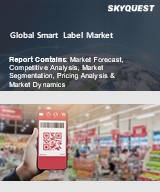
Report ID: SQSG45E2017

Report ID:
SQSG45E2017 |
Region:
Global |
Published Date: December, 2024
Pages:
157
|
Tables:
98 |
Figures:
76
In 2021, the North American segment held the largest share for the global smart label market. The basic goal of smart labels is to speed up digital access to information. The percentage of the population in the Americas that can access a mobile cellular signal, or mobile cellular coverage, is assessed by the ITU to be 95.5%. 95.5 percent of the population can get a 3G signal, and 88.7 percent can access a long-term evolution (LTE) mobile broadband signal, according to statistics on 3G and 4G coverage. At the end of 2019, there was a large use disparity, with the percentage of people using the Internet rising from 72.2% in 2017 to 76.7%. By the end of 2019, 69.8% of households had access to the Internet at home, up from 66.7% in 2017.
One of the first nations to use QR codes was the United States. Its use has since sharply grown. According to Statista research, 11 million US homes alone scanned a QR code in 2020. From 9.76 million scans in 2018, there has been a considerable increase. 18.8% of American customers strongly agreed that they had seen an increase in the usage of QR codes since the start of COVID-19-related shelter-in-place orders in March 2020, according to a September 2020 poll by Statista.
During the projected period, the Asia Pacific is anticipated to facilitate a fantastic CAGR in the global smart label market. Demand for intelligent labels in the region is probably being driven by government regulations and legislation requiring that products be labeled. A proposal to put barcodes or rapid response (QR) tags on the packaging of 300 of the most popular medications in India has been reintroduced in order to ease product verification. The rule is expected to go into effect at the beginning of May 2023. Drug packaging barcode proposals have existed since the Indian government published a draft proposal for comment in 2015. According to the most recent suggestion, a barcode or QR code should have eight bits of data: a unique product identification code, generic name, brand name, production date, batch number, expiration date, and manufacturing license number.
Our industry expert will work with you to provide you with customized data in a short amount of time.
REQUEST FREE CUSTOMIZATIONWant to customize this report? This report can be personalized according to your needs. Our analysts and industry experts will work directly with you to understand your requirements and provide you with customized data in a short amount of time. We offer $1000 worth of FREE customization at the time of purchase.

Report ID: SQSG45E2017